I love velvet - smooth one way, slightly rough the other way; soft, elegant and lovely. That said, it can be tricky to sew because the 'nap' means when the pieces are right sides together they want to move in opposite directions. Velvet is not a slidey fabric!
This week I've been busy making more velvet purses. I designed the pattern and applique for these over a year ago, but still have lots of un-used purse frames. These might make last-minute Christmas presents, and some are going into my Etsy shop. As well as for coins, I think these would make a lovely jewellery case - for a necklace, bracelet or rings, for example.
The machine embroidery on these is done with the feed dogs down, so I can trace around these flower petals by moving the fabric in any direction under the needle. It takes a bit of getting used to, but for designs like this it's essential - this would be so difficult to sew using straight stitching!
In the centre of this flower (and the one on the blue purse) I've added a small shell button and tiny seed beads, by hand. All of this embellishment is done before I stitch the two pieces of velvet together to make the purse outer.
Once the lining is made I press the seams, place the lining inside the outer, press the top edges inwards and oversew them together. Then it's time to glue the purse into its frame, which takes a bit of patience! I like to glue the front in first, because it's usually slightly easier to get a neat and tidy glue-free finish on the first side you do. And if there's going to be glue on the velvet, I'd rather it was on the back (although you can remove tiny bits with nail polish remover).
If you like these, please do look in the shop!
Pages
Search This Blog
Friday, 20 December 2013
Sunday, 1 December 2013
Covered journal notebook
I've been working on some new notebooks, this time with some wonderful woven felt from RayStitch, and machine applique.
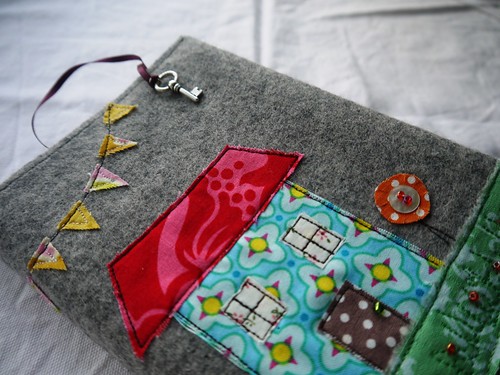
I first stitched this design for a New Home card for a friend, and liked it so much I made another one to keep straight away. And I still like it, so I'm using it again! I found these tiny key charms to tie on the end of a ribbon bookmark.

The garden, made with free machine embroidery, buttons and beads.
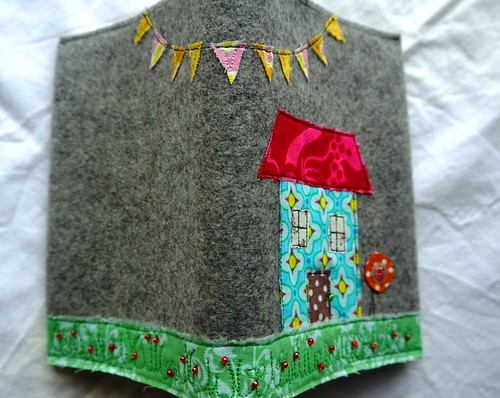
The garden and the bunting wrap around to the back of the journal, for extra interest.
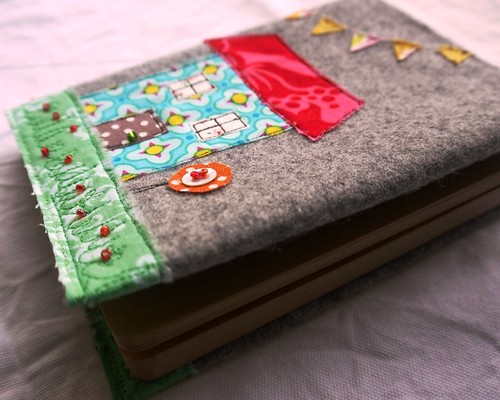
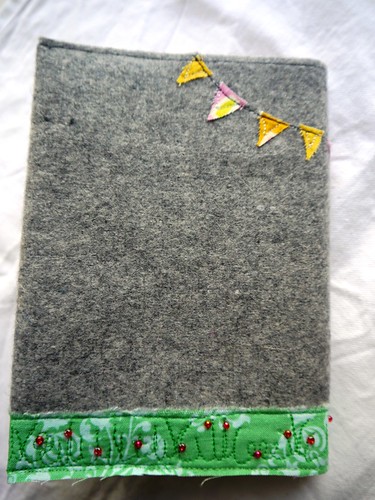
Now for sale in my shop, if you would like your own!

I first stitched this design for a New Home card for a friend, and liked it so much I made another one to keep straight away. And I still like it, so I'm using it again! I found these tiny key charms to tie on the end of a ribbon bookmark.

The garden, made with free machine embroidery, buttons and beads.

The garden and the bunting wrap around to the back of the journal, for extra interest.


Now for sale in my shop, if you would like your own!
Wednesday, 20 November 2013
New shop!
I've taken the plunge and listed a couple of things in a new Etsy shop! Have a look here (new shop) or on the Shop tab above and leave me a comment below if you like. I'll add more things very soon.
So far, there's this quilt, and this bag.
Hoping to add some more in the next week x
So far, there's this quilt, and this bag.
| Bag | Quilt |
|---|---|
 |

|
Hoping to add some more in the next week x
Friday, 25 October 2013
Hexagonal work in progress
I've been working on some hexagons, inspired by this quilt, using up fabric I already had in some muted, modern colours. I don't have a pattern, but I do have a ruler with a 60 degree angle marked on it, so I studied how other people had created hexagons and off I went.

For each segment of a hexagon, I'm sewing a 60 degree triangle to a strip of fabric, then trimming the joined pieces into a large 60 degree triangle. Then I sew three of those together to make a half hexagon. Eventually I'll lay out all of those how I want them in the quilt, and join them into vertical strips; then when the strips are joined, the full hexagons will appear without me having to sew complicated Y seams.
And to finish here's a trial quilt layout, with some sage green chambray fabric from Village Haberdashery (London)

For each segment of a hexagon, I'm sewing a 60 degree triangle to a strip of fabric, then trimming the joined pieces into a large 60 degree triangle. Then I sew three of those together to make a half hexagon. Eventually I'll lay out all of those how I want them in the quilt, and join them into vertical strips; then when the strips are joined, the full hexagons will appear without me having to sew complicated Y seams.
And to finish here's a trial quilt layout, with some sage green chambray fabric from Village Haberdashery (London)
Thursday, 10 October 2013
Orange peel
Just a quick post with picture of Not Orange Peel finally finished. There was only just enough sunlight to get these pics...
First the whole quilt, showing how the stems (of varying lengths) and leaves are laid out:
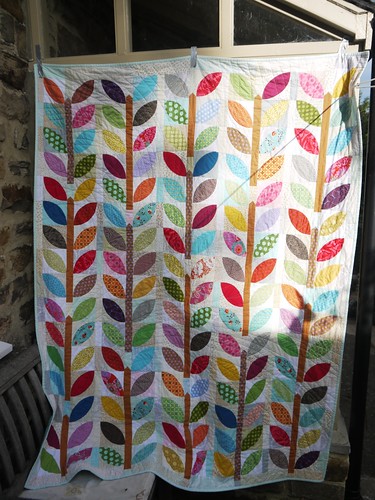
Some quilting detail: the lines were machine quilted in expanding curves - marked out in washable pen

Along one side of the back, a rainbow stripe which uses one piece of every "leaf" fabric used on the front:
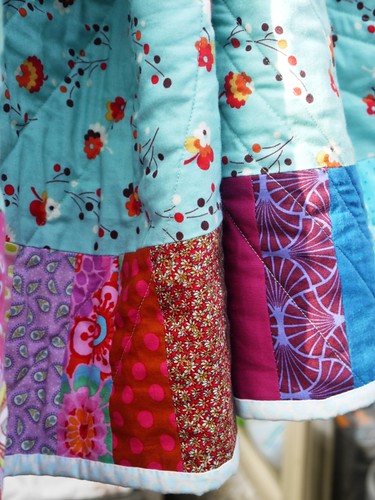
More quilting action:
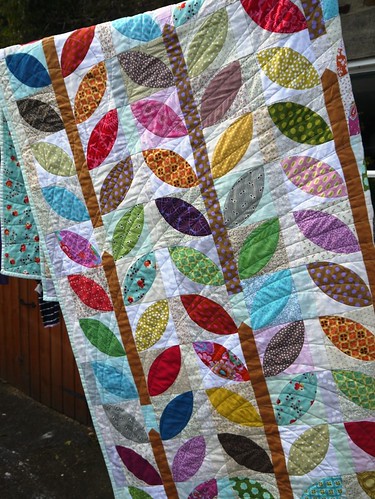
And another part of the rainbow strip

I have to say it turned out looking really nice, and I'm very pleased with it.
Next quilt has hexagons on....
First the whole quilt, showing how the stems (of varying lengths) and leaves are laid out:

Some quilting detail: the lines were machine quilted in expanding curves - marked out in washable pen

Along one side of the back, a rainbow stripe which uses one piece of every "leaf" fabric used on the front:

More quilting action:

And another part of the rainbow strip

I have to say it turned out looking really nice, and I'm very pleased with it.
Next quilt has hexagons on....
Sunday, 6 October 2013
A new sort of bag
Have you ever used coated cotton for your sewing? I'd made a few aprons from it in the past, but never ventured into the sort of "3-D" territory that I regularly do with ordinary fabric - until now.
I've been making some satchel-style bags and the results seem good, although I have a few further refinements in mind. The pattern I used here is a mash-up of stuff I've seen made elsewhere, and some tips from the wonderful internet, with my own sizes and ways of finishing things thrown in!
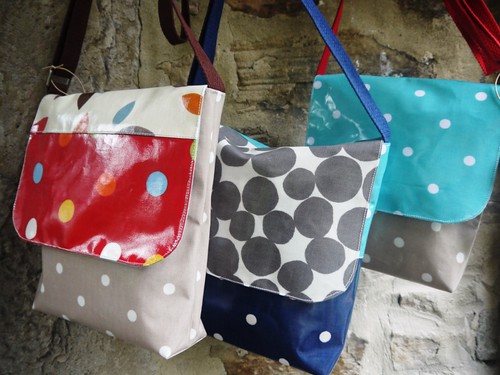
Above are some bags I recently finished, using up some scraps of coated cotton and some bigger new bits.
So here are my top tips for sewing with coated cotton:
1. If you pin, make sure it's in the seam allowance. Holes in this stuff stay!
2. When sewing, your ordinary polyester thread is fine. For top-stitching you'll be better using something a bit thicker, maybe linen thread.
3. Use a big needle, it makes a great difference. I use a number 90 and it sews very well, even through two layers of coated cotton, two layers of webbing and a lining!
4. Practice sewing on a scrap before you put your project under the presser foot, to make sure your tension, stitch length etc are all good.
5. A walking foot solves all problems of this stuff sticking to the stitch plate or presser foot. They cost a little bit, but once you've got one you'll use it loads.
6. Avoid turning bags inside out and back again numerous times - you can iron coated cotton, but some creases stay longer than others.
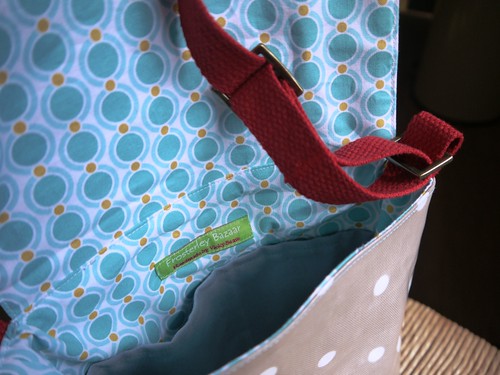
Here's the inside of a bag, showing an internal pocket and also the top edge, and strap adjuster.
Next up I'm trying coated cotton in combination with zips! Should be interesting...
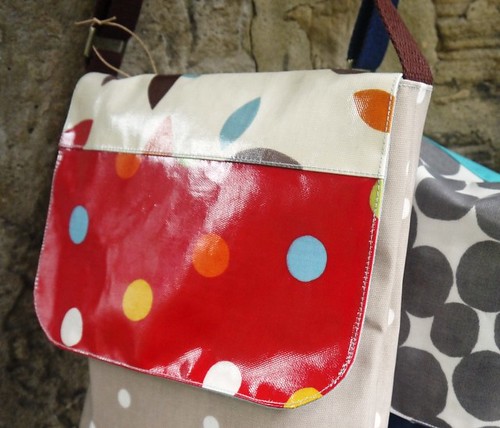
I've been making some satchel-style bags and the results seem good, although I have a few further refinements in mind. The pattern I used here is a mash-up of stuff I've seen made elsewhere, and some tips from the wonderful internet, with my own sizes and ways of finishing things thrown in!

Above are some bags I recently finished, using up some scraps of coated cotton and some bigger new bits.
So here are my top tips for sewing with coated cotton:
1. If you pin, make sure it's in the seam allowance. Holes in this stuff stay!
2. When sewing, your ordinary polyester thread is fine. For top-stitching you'll be better using something a bit thicker, maybe linen thread.
3. Use a big needle, it makes a great difference. I use a number 90 and it sews very well, even through two layers of coated cotton, two layers of webbing and a lining!
4. Practice sewing on a scrap before you put your project under the presser foot, to make sure your tension, stitch length etc are all good.
5. A walking foot solves all problems of this stuff sticking to the stitch plate or presser foot. They cost a little bit, but once you've got one you'll use it loads.
6. Avoid turning bags inside out and back again numerous times - you can iron coated cotton, but some creases stay longer than others.

Here's the inside of a bag, showing an internal pocket and also the top edge, and strap adjuster.
Next up I'm trying coated cotton in combination with zips! Should be interesting...

Saturday, 28 September 2013
Birdy book
Had an hour or two spare today, so I had a play with machine embroidery. I've made notebook covers before, but only with patchwork, but I see more covers with pictures coming soon!

I make my covers using pretty much the same method as Rachel at Stitched In Colour - a link to her tutorial is here.
The colours in these photos aren't great (summer's over!) - this blue cover is a deep turquoise, and the bird's wing deep pinky-purple. These notebooks are about A5 size. I've added a ribbon bookmark with a felt ball on the end. In fact seeing the bag of felt balls, which I've had for months but haven't got round to using (but they're lovely to play with - get yours from Blooming Felt), inspired me back into notebook-covering.
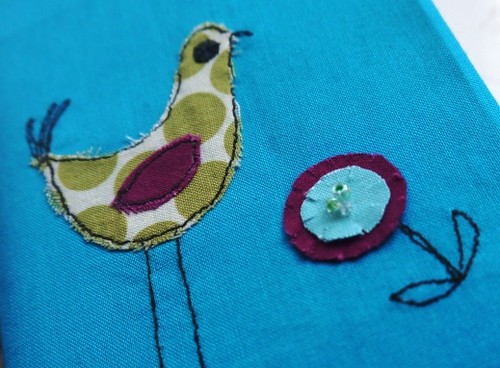
Next time I'm going to use Bondaweb to make sure there's not so much fraying on the bird shape - this time I used my standby Pritt stick. Well, it works!
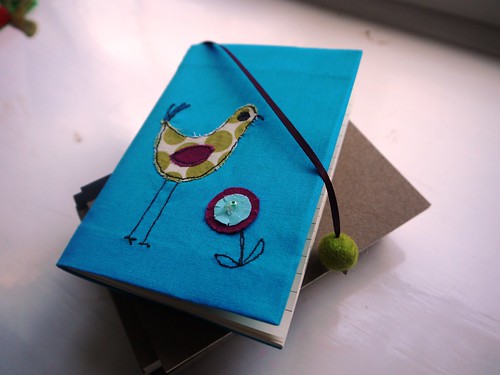
Watch this space for more notebooks soon x

I make my covers using pretty much the same method as Rachel at Stitched In Colour - a link to her tutorial is here.
The colours in these photos aren't great (summer's over!) - this blue cover is a deep turquoise, and the bird's wing deep pinky-purple. These notebooks are about A5 size. I've added a ribbon bookmark with a felt ball on the end. In fact seeing the bag of felt balls, which I've had for months but haven't got round to using (but they're lovely to play with - get yours from Blooming Felt), inspired me back into notebook-covering.

Next time I'm going to use Bondaweb to make sure there's not so much fraying on the bird shape - this time I used my standby Pritt stick. Well, it works!

Watch this space for more notebooks soon x
Sunday, 15 September 2013
Not orange peel - quilted, finished, loved
At last, it's done! I've finished machine quilting Not Orange Peel, and am really, really pleased with it!
Here are a few pics taken when I'd finished the quilting but before I'd trimmed and bound the edges.
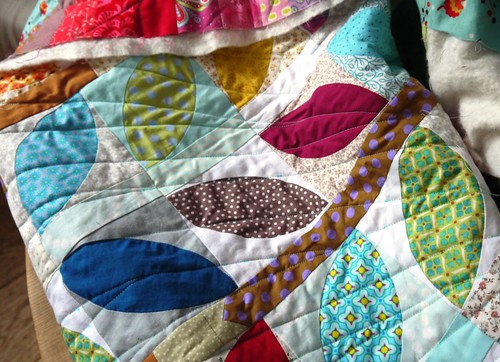
The quilting pattern was inspired by a tree, with branches flowing and dividing organically. It starts in a bottom corner, and flows up and across the quilt, curving right back on itself at the bottom and the right edges. I quilted with Guterman 100% cotton, as I couldn't get to the quilt shop to get a big reel of anything like Aurifil.

Here's the back, which is my favourite Flea Market Fancy print, plus a rainbow border made from one piece of every colour I used on the front.
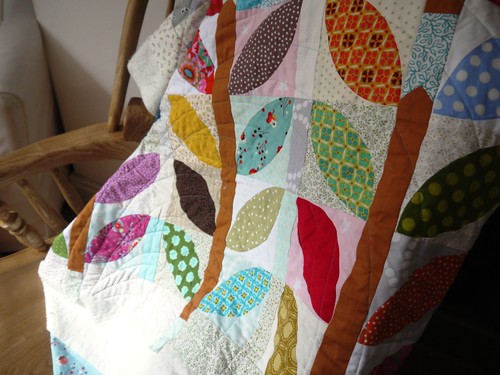
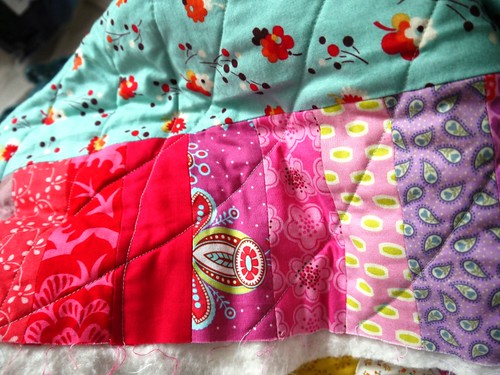
And here's the binding, ready to go on - lovely pale spots! (it's a print I used in the background of the front quite a bit)
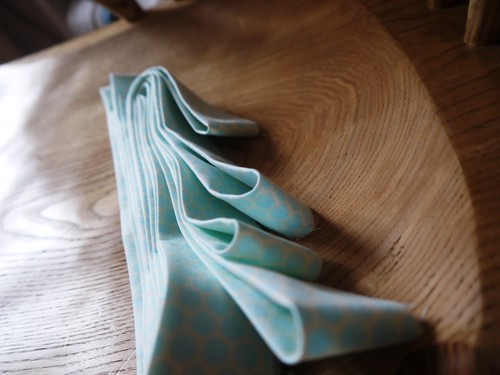
To follow very soon - pics of the completed quilt (just as soon as I can get it away from my daughter's bed, it was made for her and she really loves it already - what more could I ask?)
Here are a few pics taken when I'd finished the quilting but before I'd trimmed and bound the edges.

The quilting pattern was inspired by a tree, with branches flowing and dividing organically. It starts in a bottom corner, and flows up and across the quilt, curving right back on itself at the bottom and the right edges. I quilted with Guterman 100% cotton, as I couldn't get to the quilt shop to get a big reel of anything like Aurifil.

Here's the back, which is my favourite Flea Market Fancy print, plus a rainbow border made from one piece of every colour I used on the front.


And here's the binding, ready to go on - lovely pale spots! (it's a print I used in the background of the front quite a bit)

To follow very soon - pics of the completed quilt (just as soon as I can get it away from my daughter's bed, it was made for her and she really loves it already - what more could I ask?)
Tutorial: easy box corners
You know when you want to give your bag/purse/pouch a bit of depth at the bottom, you have to make that seam across the corner? And you know what it's like trying to fiddle around matching up the seams so it looks neat, sticking a pin through, wiggling it about a bit, making sure there's not a pleated-up bit on the other side.....well now you don't need to do all that. Here is my way of making boxed corners.
1) Sew your side and bottom seams as normal. If you're leaving a gap in the bottom seam for turning, make sure you've left enough room for the box corner seam.
2) Mark a square on each corner that you want to box. To work out the size of this square, first calculate how long you want the finished box seam to be - let's say you want an 8cm seam. This will be split between the two sides of the bag, so that's 4cm each side. Then take off your seam allowance, say 1cm, and you're left with the square size - in this case 3cm. See the diagram below! Mark this accurately (e.g. with a grid ruler) using a fading or washable marker or a pencil.
3) Get your sharp scissors out. Making sure your sewn piece is lying nice and flat, chop out this marked square - eek! A hole in your bag!!
4) Now pull the sides of the bag apart, so the seams meet (or seam and centre bottom fold in my case). Finger press seams open, check they match a little further down by peeking in, pin in place, then finger press the 45 degree fold at each edge.
5) Stitch across the raw edges you just cut and pinned, using 1cm seam. Your corner is perfectly boxed!
1) Sew your side and bottom seams as normal. If you're leaving a gap in the bottom seam for turning, make sure you've left enough room for the box corner seam.
2) Mark a square on each corner that you want to box. To work out the size of this square, first calculate how long you want the finished box seam to be - let's say you want an 8cm seam. This will be split between the two sides of the bag, so that's 4cm each side. Then take off your seam allowance, say 1cm, and you're left with the square size - in this case 3cm. See the diagram below! Mark this accurately (e.g. with a grid ruler) using a fading or washable marker or a pencil.
3) Get your sharp scissors out. Making sure your sewn piece is lying nice and flat, chop out this marked square - eek! A hole in your bag!!
4) Now pull the sides of the bag apart, so the seams meet (or seam and centre bottom fold in my case). Finger press seams open, check they match a little further down by peeking in, pin in place, then finger press the 45 degree fold at each edge.
5) Stitch across the raw edges you just cut and pinned, using 1cm seam. Your corner is perfectly boxed!
Sunday, 18 August 2013
Zip pouch with mermaids
Here's a cute little pouch I made for my daughter, she loves it! The pattern is from Noodlehead's tutorial for a wide-mouth pouch and it really works - when the zip's open you can see right in. I've used it before and I highly recommend it.
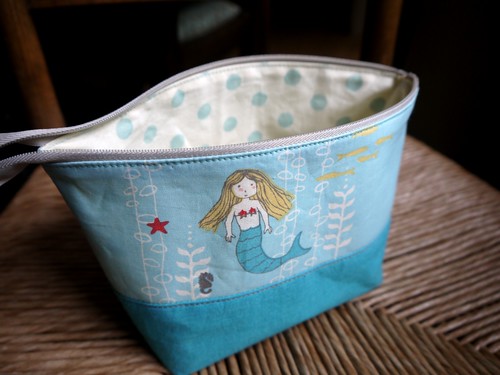
The fabric I've used here is some I dug out of a pile I bought ages ago - the beautiful mermaids are an organic print from Birch fabrics, and the solid blue is a Kaffe Fassett (no idea what the colour's called) that matches the mermaid's tail exactly.
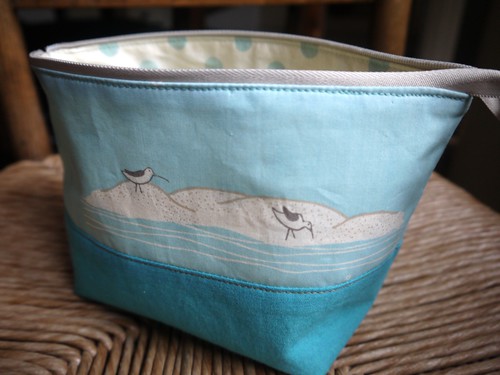
On the back I've used another part of the print, with some wading birds feeding on a sand bar. I really, really like this fabric - it's quirky but reflects nature (...cos do mermaids exist or not? What do you think?).
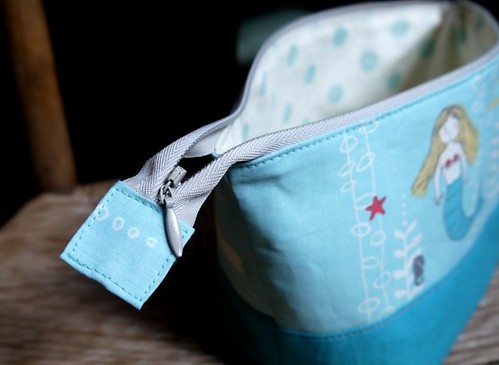
I've used an invisible zip here, but not sewn it in "invisibly". I just like the neat look when it's closed, and the little tiny zip pull. If you don't know Noodlehead's blog, do have a look (Noodlehead), she has a great selection of tutorials with clear instructions. If you try this pouch, make sure you buy a plenty long enough zip for the size you're making, as it makes all the difference being able to pull the zip right past the end of the pouch.
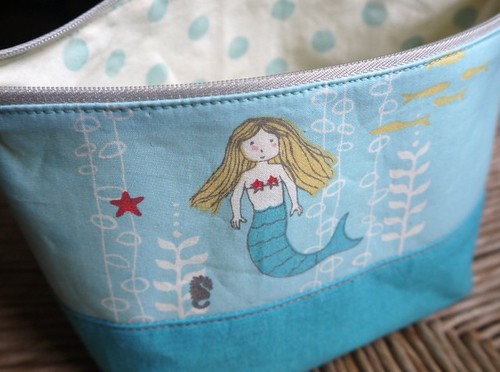 Bye for now x
Bye for now x

The fabric I've used here is some I dug out of a pile I bought ages ago - the beautiful mermaids are an organic print from Birch fabrics, and the solid blue is a Kaffe Fassett (no idea what the colour's called) that matches the mermaid's tail exactly.

On the back I've used another part of the print, with some wading birds feeding on a sand bar. I really, really like this fabric - it's quirky but reflects nature (...cos do mermaids exist or not? What do you think?).

I've used an invisible zip here, but not sewn it in "invisibly". I just like the neat look when it's closed, and the little tiny zip pull. If you don't know Noodlehead's blog, do have a look (Noodlehead), she has a great selection of tutorials with clear instructions. If you try this pouch, make sure you buy a plenty long enough zip for the size you're making, as it makes all the difference being able to pull the zip right past the end of the pouch.
 Bye for now x
Bye for now x
Tuesday, 9 July 2013
Not orange peel - ready to quilt!
My quilt in progress, which I called Not Orange Peel in this post, is finally ready to quilt. I think I started this one in mid-February, since when progress has been slow as I mused about how to join everything together, which way to press the seams, how big to make it, etc.
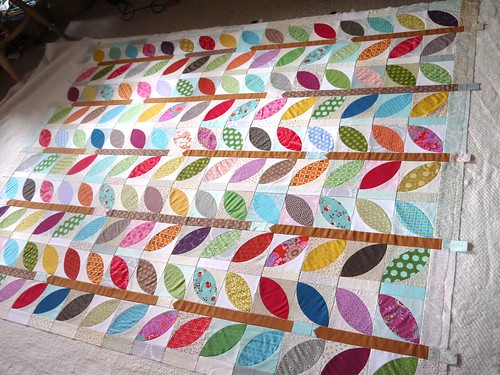
A few weeks ago I finished joining all my leaf blocks together after looking at them pinned to the wall for months on end, and then further delay trying to find the right colour for the stems (not to mention then starting to put the stems in, and deciding they needed pointy tops instead of flat tops....). The random-ness of the stem lengths was important - at first I thought I could put in five full-length stems, but that didn't work; the quilt top needed to be broken up by having shorter stems so that the leaves, rather than the stems, were the main feature (thanks to my husband Mike for this inspiration!). Here's how it looked half-way through piecing, when I was starting to think about the stems:
So now it's basted and ready to go. Quilting will be by machine, in a sort-of tree-like pattern that flows from a bottom corner towards the top, spreading out as it goes. I'll be doing that on my little Elna machine, with a walking foot and a washable marker!

A few weeks ago I finished joining all my leaf blocks together after looking at them pinned to the wall for months on end, and then further delay trying to find the right colour for the stems (not to mention then starting to put the stems in, and deciding they needed pointy tops instead of flat tops....). The random-ness of the stem lengths was important - at first I thought I could put in five full-length stems, but that didn't work; the quilt top needed to be broken up by having shorter stems so that the leaves, rather than the stems, were the main feature (thanks to my husband Mike for this inspiration!). Here's how it looked half-way through piecing, when I was starting to think about the stems:
So now it's basted and ready to go. Quilting will be by machine, in a sort-of tree-like pattern that flows from a bottom corner towards the top, spreading out as it goes. I'll be doing that on my little Elna machine, with a walking foot and a washable marker!
Monday, 8 July 2013
Next quilt on my list...
...is this beauty from Julie at Jaybird Quilts.

I'm a scientist when I'm not quilting and I love that this quilt combines both. Those hexagons could be just hexagons - one of the oldest patchwork shapes we know - or they could be any number of things in the world of science: how about benzene rings, phenolic groups, bee honeycomb, crystals, part of a DNA helix, a constellation....any suggestions?!
At the moment I can't decide if I like the white background or the grey. My sister has requested one in grey, so maybe I'll start with that and see whether to repeat it for myself or go white! But first, of course, there are other projects to tidy up. . .
(PS I asked Julie if I could post this photo with a link but I haven't heard back from her in the five weeks since I asked, so I'm cautiously going ahead with this post!)

I'm a scientist when I'm not quilting and I love that this quilt combines both. Those hexagons could be just hexagons - one of the oldest patchwork shapes we know - or they could be any number of things in the world of science: how about benzene rings, phenolic groups, bee honeycomb, crystals, part of a DNA helix, a constellation....any suggestions?!
At the moment I can't decide if I like the white background or the grey. My sister has requested one in grey, so maybe I'll start with that and see whether to repeat it for myself or go white! But first, of course, there are other projects to tidy up. . .
(PS I asked Julie if I could post this photo with a link but I haven't heard back from her in the five weeks since I asked, so I'm cautiously going ahead with this post!)
Sunday, 16 June 2013
My Snawheid mittens
Back in March I posted about the Snawheid hat I knitted using Kate Davies' pattern. Here I've taken it one step further!

The hat turned out so well I was inspired to make mittens to go with it, and I started one almost straight away.
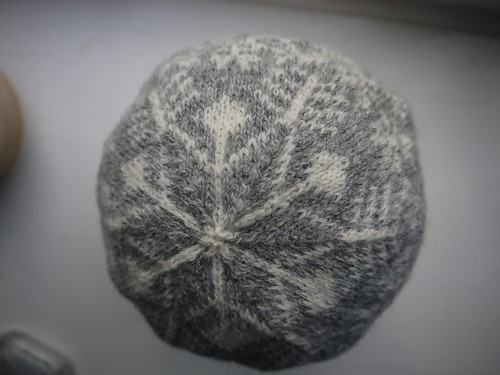
That was finished by Easter, but then I knitted another mitten (different yarn, different pattern) before I got round to ordering more of the Jamieson & Smith yarn for the second Snawheid mitten - so there has been a slight delay in getting the pair of these ready to wear. But now here they are, after a week's holiday on Tiree (Scottish Western Isles) I've had time to finish that second one off (and the weather is still just about chilly enough to wear them!).

The colourwork makes these very cosy and snug, and after a gentle wash the yarn has come up feeling lovely and soft and full. As I mentioned in my previous post, I mashed up Kate's snowflake motif with the Lusekofte-sque mittens pattern from Ravelry and am really happy with the result! I put rows of three and four snowflakes on the back of the mittens and left the palms plain. From the Lusekofte-sque pattern, apart from the shape, I borrowed the border pattern.
The mitten pattern has a double thickness cuff at the top and bottom which I love, and I think it might translate onto socks quite nicely...
I did make these slightly bigger than the Lusekofte-sque pattern, adding an extra ten stitches to the width (I think!) and ten rows to the length, as well as an additional two stitches to the thumb and two extra rows (but I do seem to have fairly big hands).
The weather hasn't been too chilly lately so I'm hoping not to need these till winter starts. In the meantime, the garden's looking lovely....
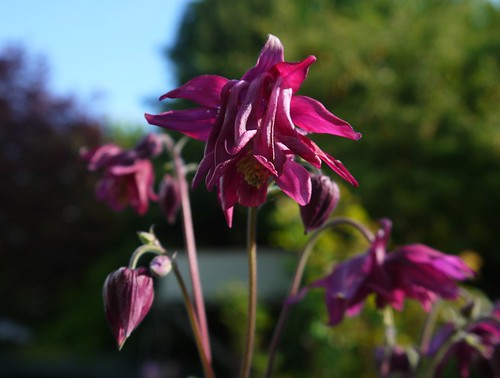
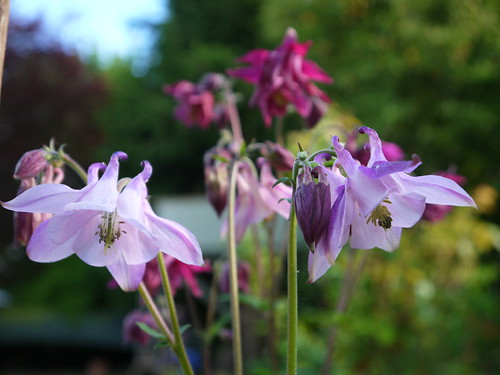

The hat turned out so well I was inspired to make mittens to go with it, and I started one almost straight away.

That was finished by Easter, but then I knitted another mitten (different yarn, different pattern) before I got round to ordering more of the Jamieson & Smith yarn for the second Snawheid mitten - so there has been a slight delay in getting the pair of these ready to wear. But now here they are, after a week's holiday on Tiree (Scottish Western Isles) I've had time to finish that second one off (and the weather is still just about chilly enough to wear them!).

The colourwork makes these very cosy and snug, and after a gentle wash the yarn has come up feeling lovely and soft and full. As I mentioned in my previous post, I mashed up Kate's snowflake motif with the Lusekofte-sque mittens pattern from Ravelry and am really happy with the result! I put rows of three and four snowflakes on the back of the mittens and left the palms plain. From the Lusekofte-sque pattern, apart from the shape, I borrowed the border pattern.
The mitten pattern has a double thickness cuff at the top and bottom which I love, and I think it might translate onto socks quite nicely...
I did make these slightly bigger than the Lusekofte-sque pattern, adding an extra ten stitches to the width (I think!) and ten rows to the length, as well as an additional two stitches to the thumb and two extra rows (but I do seem to have fairly big hands).
The weather hasn't been too chilly lately so I'm hoping not to need these till winter starts. In the meantime, the garden's looking lovely....


Wednesday, 29 May 2013
The Tiree pebble
We're on holiday! Last Saturday we caught a really early ferry out of Oban to the tiny island of Tiree, right on the western edge of the Scottish Hebrides.
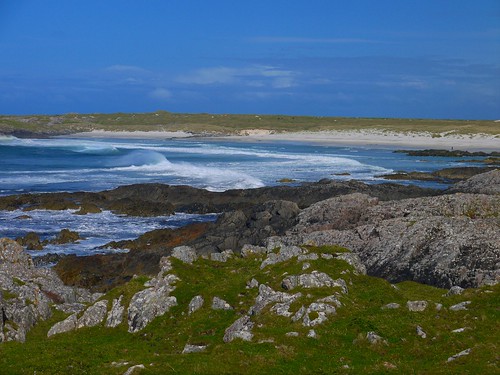
There's not much here, but there's beautiful beaches with beautiful pebbles and there's sheep's wool on the fences and beaches (I brought some fleece with me too, just in case). (If you're new to felted stones, see my original post for how I got inspired to make these).
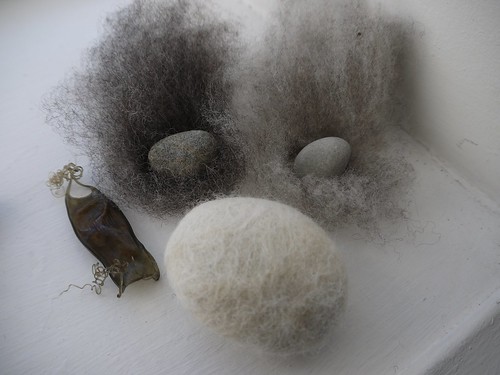
This white wool was from a beach at Hynish, in the south of the island. I've no idea what breed of sheep this is from! I washed it with hand-soap to remove the lanolin and as much of the dirt as I could and teased it out, then let it dry. Once it was dry I teased it out a bit more, then made it into a layer I could wrap round a pebble. It wasn't as easy as using the combed fleece, because in that all the fibres lie in the same direction and it's easier to wrap it snugly round the pebble. However, I managed, and felted it as usual - the wool did go very baggy during the felting but eventually formed a good and fairly even layer. (Also in the picture above are too small pebbles ready to be felted with wool from Weardale - I like their little explosive haircuts!).

This white wool has definitely formed felt, but it remains quite fuzzy. My best felting action cannot seem to get these surface fibres to knit in! I noticed the same thing when I used white fleece from my previous felt kit; other wool types seem to make denser, closer felt - but this has its own character.
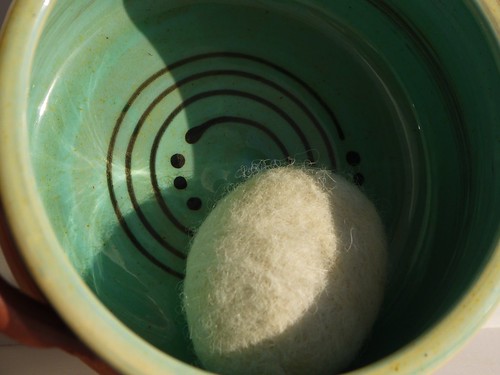
So here is a memento of our holiday - a pebble from Tiree, felted in wool from Tiree! And, in this picture, picture nestling in a lovely new dish from Tyrii pottery.
Hoping your weather is as lovely as ours up here x

There's not much here, but there's beautiful beaches with beautiful pebbles and there's sheep's wool on the fences and beaches (I brought some fleece with me too, just in case). (If you're new to felted stones, see my original post for how I got inspired to make these).

This white wool was from a beach at Hynish, in the south of the island. I've no idea what breed of sheep this is from! I washed it with hand-soap to remove the lanolin and as much of the dirt as I could and teased it out, then let it dry. Once it was dry I teased it out a bit more, then made it into a layer I could wrap round a pebble. It wasn't as easy as using the combed fleece, because in that all the fibres lie in the same direction and it's easier to wrap it snugly round the pebble. However, I managed, and felted it as usual - the wool did go very baggy during the felting but eventually formed a good and fairly even layer. (Also in the picture above are too small pebbles ready to be felted with wool from Weardale - I like their little explosive haircuts!).

This white wool has definitely formed felt, but it remains quite fuzzy. My best felting action cannot seem to get these surface fibres to knit in! I noticed the same thing when I used white fleece from my previous felt kit; other wool types seem to make denser, closer felt - but this has its own character.

So here is a memento of our holiday - a pebble from Tiree, felted in wool from Tiree! And, in this picture, picture nestling in a lovely new dish from Tyrii pottery.
Hoping your weather is as lovely as ours up here x
Thursday, 23 May 2013
The Graham quilt
Chances are, you won't have heard of the Graham quilt. It now belongs to Killhope Lead Mining Museum (have I mentioned them before?!), but its story starts about 150 years ago in nearby Allendale. And in between Allendale and Killhope, which are about a mile apart up at the tippety-top of the North Pennines, there's a journey to New York state and back.
Made by Hannah Peart in the early 19th century, the quilt is a traditional design known as a strippy quilt - literally meaning it's made of strips of fabric. This method of quilt-making is very much associated with this area, the North Country (really County Durham and Northumberland).
The quilt top is made of three or four different prints, in seven strips running the entire length of the quilt. Some of the fabrics are pretty faded now, which isn't surprising given the age of this quilt, and it's hard to know what the original colours would have looked like - I suspect there may have been quite a lot more red in the stripes that are now orange.
The back is a fairly coarse, creamy colour cotton. All of the piecing and quilting has been done by hand on this double size quilt, and the edges are finished by folding them over to the back and stitching down.
In 1854, Hannah emigrated from her home in the North Pennines to join her sweetheart Joseph Graham in New York state, taking the quilt with her. He had travelled there a few years earlier to seek a better life in farming than he could make in mining in Weardale. Hannah and Joseph married and spent the rest of their lives in America, writing home regularly to their family still in the North Pennines. Joseph died in 1905, and Hannah in 1911.
Here's a picture of the quilt back, showing some of the quilting, which includes patterns in parallel lines, scallops and four-petalled flowers (you can see one petal in the picture above, enclosed in a diamond shape). There are a few holes in the quilt back, but they don't look like moth holes. In the photo below you can see quilting in scallops following the printed pattern on the fabric.
Amazingly, although Hannah didn't return to the UK, her quilt did. In the 1980s, her great-grand-daughter brought the quilt, and letters sent to Hannah in America, back to the UK and presented them to the museum. So this quilt, over 150 years old, is now back where it started and soon it will be on display to the public alongside the letters that Hannah and her family sent back and forth to each other across the sea. It's an amazing story!
Made by Hannah Peart in the early 19th century, the quilt is a traditional design known as a strippy quilt - literally meaning it's made of strips of fabric. This method of quilt-making is very much associated with this area, the North Country (really County Durham and Northumberland).
The quilt top is made of three or four different prints, in seven strips running the entire length of the quilt. Some of the fabrics are pretty faded now, which isn't surprising given the age of this quilt, and it's hard to know what the original colours would have looked like - I suspect there may have been quite a lot more red in the stripes that are now orange.
The back is a fairly coarse, creamy colour cotton. All of the piecing and quilting has been done by hand on this double size quilt, and the edges are finished by folding them over to the back and stitching down.
In 1854, Hannah emigrated from her home in the North Pennines to join her sweetheart Joseph Graham in New York state, taking the quilt with her. He had travelled there a few years earlier to seek a better life in farming than he could make in mining in Weardale. Hannah and Joseph married and spent the rest of their lives in America, writing home regularly to their family still in the North Pennines. Joseph died in 1905, and Hannah in 1911.
Here's a picture of the quilt back, showing some of the quilting, which includes patterns in parallel lines, scallops and four-petalled flowers (you can see one petal in the picture above, enclosed in a diamond shape). There are a few holes in the quilt back, but they don't look like moth holes. In the photo below you can see quilting in scallops following the printed pattern on the fabric.
Amazingly, although Hannah didn't return to the UK, her quilt did. In the 1980s, her great-grand-daughter brought the quilt, and letters sent to Hannah in America, back to the UK and presented them to the museum. So this quilt, over 150 years old, is now back where it started and soon it will be on display to the public alongside the letters that Hannah and her family sent back and forth to each other across the sea. It's an amazing story!
Subscribe to:
Comments (Atom)













